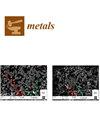热处理对热轧 17-7 PH 不锈钢等离子氮化的影响
IF 2.5
3区 材料科学
Q3 MATERIALS SCIENCE, MULTIDISCIPLINARY
引用次数: 0
摘要
17-7 PH 不锈钢是一种用途非常广泛的材料,在航空航天、化学和石化以及医药等多个领域都有广泛的应用。这种材料具有优异的机械性能和耐腐蚀性,是众多部件和仪器的最佳选择。然而,17-7 PH 不锈钢的表面性能不足以满足某些极端环境下对高硬度和耐磨性的要求。由于 17-7 PH 不锈钢具有出色的机械性能和耐腐蚀性,因此可用于制造制药设备部件。但在某些特殊环境下,仍需要进行表面氮化处理。考虑到这种材料需要复杂的热处理工艺,本文详细研究了 17-7 PH 钢在时效热处理后进行离子氮化前后的表面性能变化。研究采用轧制的 17-7 PH 不锈钢作为研究对象。通过比较和分析热处理前后材料马氏体含量和马氏体内位错密度对氮化后钢表面氮化层硬度、厚度和耐腐蚀性的影响,研究了热处理对不锈钢等离子氮化的影响。结果表明,未进行热处理的 17-7 PH 不锈钢内部位错密度高,氮化效率高,因此表面硬度也高。经过热处理后,17-7 PH 不锈钢的马氏体含量增加,位错含量减少,基体硬度增加。本文章由计算机程序翻译,如有差异,请以英文原文为准。
The Effect of Heat Treatment on the Plasma Nitriding of Hot-rolled 17–7 PH Stainless Steel
17–7 PH stainless steel is a highly versatile material with a multitude of applications in a diverse range of fields, including aerospace, chemistry and petrochemistry, and medicine. The material’s exceptional mechanical properties and corrosion resistance render it the optimal selection for numerous components and instruments. Nevertheless, the surface properties of 17–7 PH stainless steel are inadequate for applications requiring high hardness and wear resistance in certain extreme environments. Due to its excellent mechanical properties and corrosion resistance, it can be utilized in the manufacturing of pharmaceutical equipment components. However, certain specialized environments still require surface nitriding treatment. Considering the complex heat treatment process required for this material, this paper reports a detailed study of the surface performance changes of 17–7 PH steel before and after ion nitriding following aging heat treatment. The study employs rolled 17–7 PH stainless steel as the subject material. The impact of heat treatment on plasma nitriding of stainless steel is investigated by comparing and analyzing the influence of martensite content and dislocation density within the martensite of the material prior to and following heat treatment on the hardness, thickness, and corrosion resistance of the nitrided layer on the surface of the steel after nitriding. The results demonstrate that 17–7 PH stainless steel, which does not undergo heat treatment, exhibits a high internal dislocation density, a high nitriding efficiency, and consequently, a high surface hardness. Following the application of a heat treatment, there is an increase in the martensite content of 17–7 PH stainless steel, a decrease in the dislocation content, and an increase in the matrix hardness.
求助全文
通过发布文献求助,成功后即可免费获取论文全文。
去求助
来源期刊

Metals
MATERIALS SCIENCE, MULTIDISCIPLINARY-METALLURGY & METALLURGICAL ENGINEERING
CiteScore
4.90
自引率
13.80%
发文量
1832
审稿时长
1.5 months
期刊介绍:
Metals (ISSN 2075-4701) is an open access journal of related scientific research and technology development. It publishes reviews, regular research papers (articles) and short communications. Our aim is to encourage scientists to publish their experimental and theoretical results in as much detail as possible. Therefore, there is no restriction on the length of the papers. The full experimental details must be provided so that the results can be reproduced. Metals provides a forum for publishing papers which advance the in-depth understanding of the relationship between the structure, the properties or the functions of all kinds of metals.
 求助内容:
求助内容: 应助结果提醒方式:
应助结果提醒方式:


